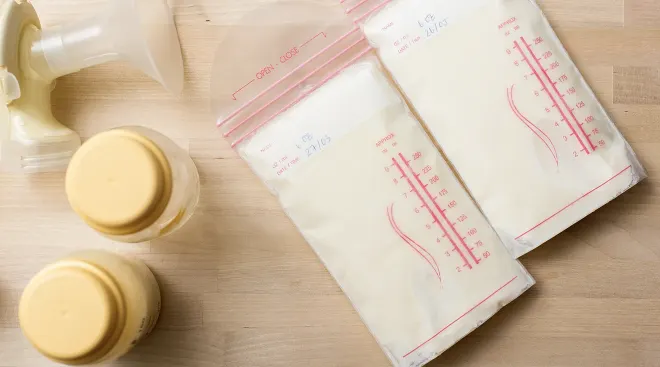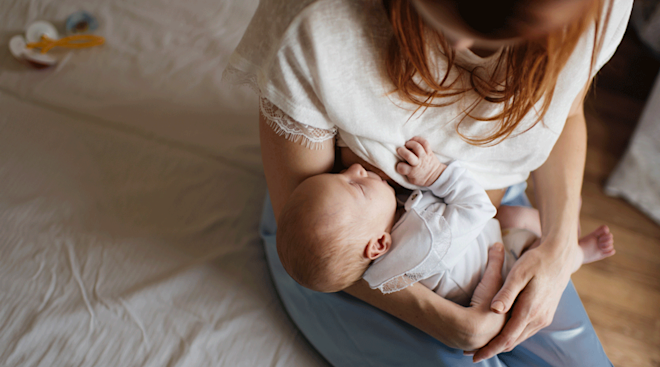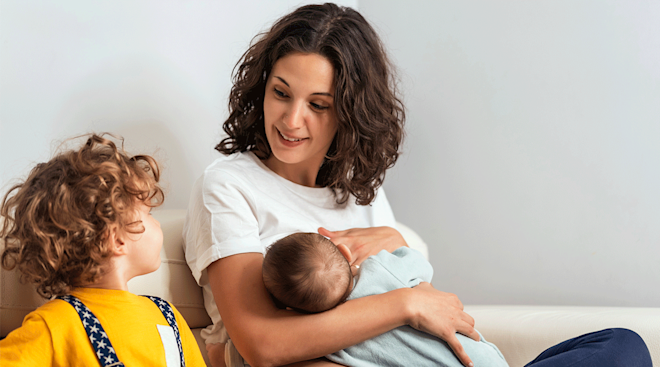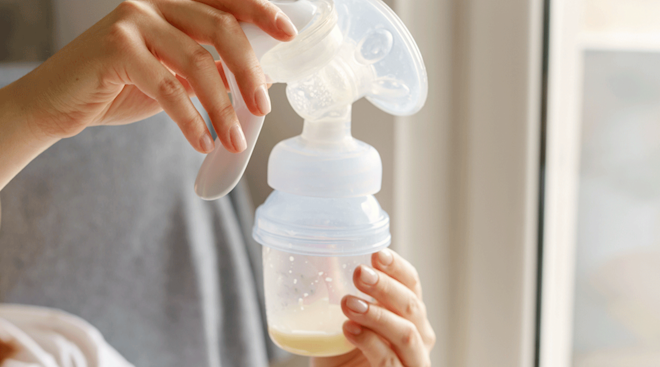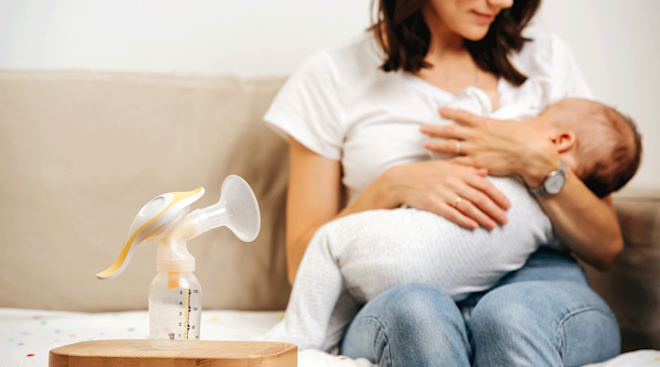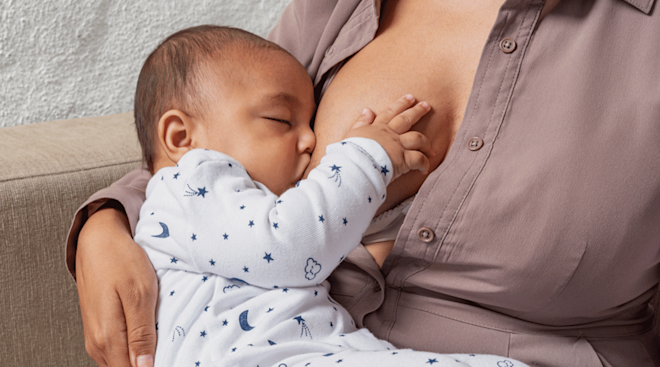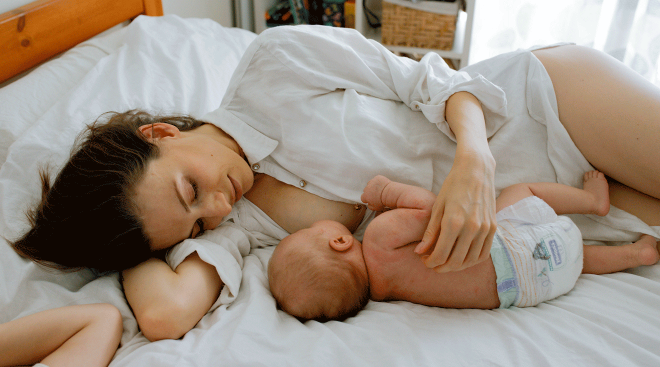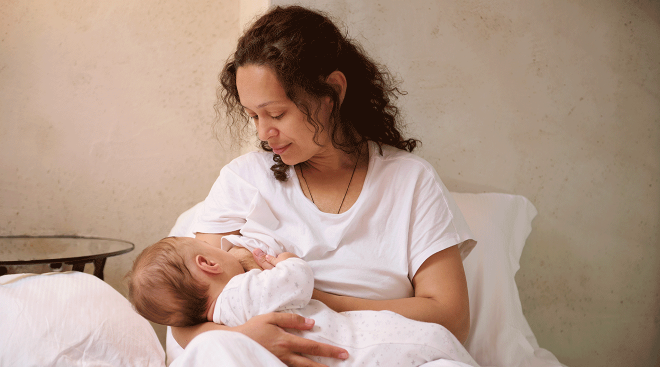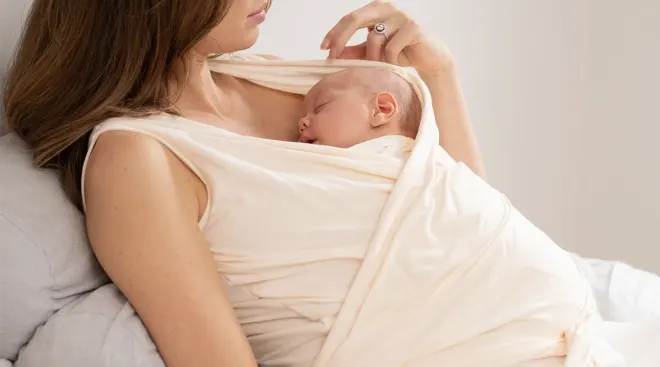How to Treat Nipple Thrush From Breastfeeding
Breastfeeding can sometimes feel like a magical experience. On the other hand, it can occasionally cause discomfort, pain and irritation. One unpleasantry you might encounter during your journey is nipple thrush. Essentially a yeast infection on your nipples (yes, this is a thing!), nipple thrush is a common condition among women who are breastfeeding—and, while annoying, it’s usually fairly easy to treat. That said, it’s important to be aware of what it looks like so you can keep an eye out for nipple thrush symptoms; if left untreated, it can lead to oral thrush in baby, which is not particularly enjoyable for them (or you). Ready to get a handle on this potential breastfeeding issue? Read on to learn everything there is to know about nipple thrush when breastfeeding, straight from experts.
Nipple thrush is a fungal condition that can cause discomfort, dry and flaky skin and nipple and breast pain. Like other yeast infections, it’s caused by an overgrowth of candida (yeast), which is is commonly found on the skin and mucous membranes, explains Rebecca Keith, MD, a board-certified ob-gyn with Pediatrix Medical Group.
When nipple thrush occurs because of breastfeeding, it’s also possible for baby to deal with thrush in their mouth, or oral thrush. “Thrush within the infant mouth presents in white patches that aren’t able to be removed via ‘wiping’ or manual removal,” says Demi Lucas, IBCLC, clinical resource manager at the Lactation Network.
Again, you can blame candida or yeast on nipple thrush. Research has shown that breastfeeding promotes for the exact type of warm, moist environment candida thrives in. The sugar found in breast milk can also be a culprit.
According to Keith, an overgrowth of candida can also be caused by cracked or damaged nipples (sometimes from improper latching), antibiotic use by the mother or nipple irritation from wearing breast pads for long periods of time.
If you have a history of vaginal thrush (aka a yeast infections down there), nipple thrush can be linked to that, says Lucas. “Breastfeeding an infant who is diagnosed with oral thrush may increase the risk of the breastfeeding parent acquiring it,” she adds, noting that sometimes the original cause is just unknown.
While it isn’t serious, nipple thrush is certainly irritating and uncomfortable. According to Keith and Lucas, symptoms include:
- Pain or burning in the nipples or breasts
- Pain that’s felt immediately after or between feeding
- Itching
- A visible rash
- Nipples that appear dark pink or red, or have a purplish hue
- Tender nipples that hurt even at the slightest touch
- A stabbing or shooting pain
- Cracking around the base of the nipple
It’s important to know that everyone can experience nipple thrush differently. “Not every patient will experience all symptoms,” Lucas says. “Some may only have one or two mild symptoms.”
Nipple thrush doesn’t necessarily look the same for everyone, Keith says. “The nipple may be unusually pink or red, flaky or cracked or blistered,” she continues. “Women may see tiny blisters or fissures (cracks). Sometimes the nipple may look normal, but excess candida is still present.”
Lucas agrees, noting that some women may not be able to see that they have thrush—they might just feel the physical symptoms. “Some people exhibit redness or a shiny appearance on the nipples/breast, whereas others simply have physical discomfort symptoms like breast pain or itching,” she adds. If you feel any of the typical symptoms but your nipples look normal, you still might want to reach out to a doctor.
If you think you have nipple thrush, it’s important to contact your provider–this isn’t something that’ll go away on its own, so you don’t want to just ignore it. Treatment is fairly simple and often includes prescription or over-the-counter medication, as well as at-home remedies you can try for relief.
Nipple thrush medications
Nipple thrush typically requires medication to fully go away. This usually consists of antifungal medications like miconazole or fluconazole, Keith says, noting these may come in the form of creams, tablets or both. “If baby has been diagnosed with thrush, they may be treated with antifungal gels or drops,” she adds.
Nipple thrush remedies to try
You can try some DIY remedies before starting medication or alongside it. “The most important thing is to keep the breast as dry as possible,” Keith stresses, since candida overgrowth is more likely to happen in a moist environment. If you’re using breast pads, she recommends changing them often or avoiding them altogether, if possible. Also avoid bras and clothing that are too tight, restrictive or that make you feel warm. Finally, Keith recommends washing all clothing worn when you have thrush in hot soapy water and air drying it outside.
“Some women may try using a diluted vinegar solution that can be applied to your nipples in between feedings,” Keith suggests.
Preventing nipple thrush is all about avoiding the type of warm, moist environment that can lead candida growth. “It’s important to keep nipples dry,” Keith reiterates. Again, change your breast pads often—especially if you notice a leak on them—and ensure the bras you wear are clean and dry.
Aside from these basic breast hygiene practices, Lucas recommends exposing your nipples to some air if you suspect thrush may be starting. She also notes that if you have to take an antibiotic, you should also take a “quality probiotic” afterwards to “replenish the good bacteria” in your gut.
Frequently Asked Questions
Can I keep breastfeeding with nipple thrush?
The good news? Nipple thrush won’t keep you from nursing. “You can certainly keep breastfeeding after being diagnosed with nipple thrush,” Keith says. She recommends being sure to follow basic hygiene practices like washing your hands thoroughly. Both Keith and Lucas say it’s important to take the oral medication or apply topical medication you’ve been prescribed even while breastfeeding and to sterilize all bottles, pacifiers and toys that baby puts in their mouth. Keith advises against freezing expressed milk while being treated for thrush. “Freezing doesn’t kill candida.”
Will thrush from breastfeeding go away on its own?
Nipple thrush doesn’t go away on its own and requires medication in order to be properly treated, Keith.
Can nipple thrush affect my milk supply?
While nipple thrush itself can’t affect your milk supply, the symptoms from it can make some women avoid breastfeeding because of the pain, thus negatively affecting their supply. “Since breast milk is usually produced based on supply and demand, if the demand is decreased then the supply will be decreased,” Keith explains. “It’s important for women to try and continue to breastfeed. If it’s too painful, you can try pumping.” If you do try pumping, be sure to wash and sterilize all materials used so that the equipment doesn’t end up reinfecting you down the line.
What should I do if my baby has thrush?
Thrush in babies can present as white spots on their tongues, gums, roofs of their mouth or inside their cheeks that don’t go away with gentle wiping, explains Keith, noting that it can also look like a white film on their lips. Lucas says another sign can be a persistent diaper rash that doesn’t go away with diaper cream use. “It’s very common for both Mom and baby to have thrush simultaneously,” Keith says. “If you notice these symptoms, you want to notify the baby’s medical provider so that they can receive treatment.” Babies are usually treated with antifungal drops or gels.
Please note: The Bump and the materials and information it contains are not intended to, and do not constitute, medical or other health advice or diagnosis and should not be used as such. You should always consult with a qualified physician or health professional about your specific circumstances.
Plus, more from The Bump:
Rebecca Keith, MD, is a board-certified ob-gyn with Pediatrix Medical Group. She earned her medical degree from Indiana University School of Medicine.
Demi Lucas, IBCLC, serves as clinical resource manager at the Lactation Network.
UR Medicine Golisano Children’s Hopsital, Treating Yeast While Breastfeeding
Advances in Dermatology and Allergology, Nipple candidiasis and painful lactation: an updated overview, April 2022
Learn how we ensure the accuracy of our content through our editorial and medical review process.
Navigate forward to interact with the calendar and select a date. Press the question mark key to get the keyboard shortcuts for changing dates.

































